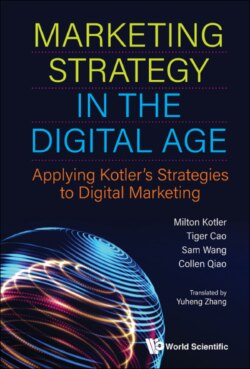Читать книгу Marketing Strategy In The Digital Age: Applying Kotler's Strategies To Digital Marketing - Milton Kotler - Страница 32
1.3.2 Traditional B2B player: Volvo
ОглавлениеThe sales network of Volvo consists of about 2,300 local distributors among over 100 countries. From 1927 to date, in order to catch up with the times, Volvo has rightly identified the importance of digital technologies and digital marketing to the changing business models. Like traditional B2B enterprises, Volvo in the past put its marketing efforts on how to maintain good relations with channel partners and end clients, but now they expect to have direct contact with end users — drivers by digital transformation. This model is called the B2B+B2C mode (Figure 1.12).
Providing new digital services and building a dynamic digital functionality at the global level are the two main directions of Volvo’s digital marketing strategy.
▪ Digital services: Volvo has established a comprehensive social media channel to directly communicate with customers through the Internet. With Facebook, Twitter and YouTube as the main platforms for brand communication, it also has an independent customer service portal (Figure 1.13).
Figure 1.12. Volvo’s digital transformation strategy.
Source: M. Tannou and G. Westerman, Volvo: From B2B to B2B+B2C Company.
At the mobile end, Volvo has developed two unique functions: remote control system and calling service. Users can have access to both tools by cell phone.
▪ Remote Control: Volvo clients can remotely control the function of the car via mobile phones, such as starting the air conditioner, controlling the door lock, checking the dashboard, locating the car and so on. This significantly betters the user experience.
▪ Volvo Calling Service: Volvo provides emergency services on motorways through a local call center and Volvo customers can access the Volvo call center directly via the first aid button on the car or the mobile app. Through the GPS in the car, the call center can provide a full selection of package services: reaching the distributor nearby, calling a trailer or giving out an alarm. Once a traffic accident occurs, the calling service is initiated automatically.
Figure 1.13. Volvo’s social media engagement.
Source: Volvo.
Laying emphasis on value-added service also increases the stickiness and loyalty of the clients of Volvo and creates more opportunities for distributors and clients to contact each other. Value-added services help to know the needs of clients in different regions and better meet their demand.
▪ Digital capabilities at the global level: Collect and aggregate global customer data and upgrade CRM systems to be global. Volvo creates a unified storage database, integrates existing data (mostly from regional agents) and sets up a digital process to continuously enrich and update the data. “‘We got numerous data from our dealers,’ said Paulsson, Volvo’s senior brand manager. ‘If we can collect the data of our products, our distributors and our customers, we can have an overall understanding of the business. Analyzing the data can help us find the way forward. We have achieved very significant results and we have already known who our customers are, what products they buy from us, how often they buy as well as have after-sales service and how big their budgets are. Unlike using the conventional product segmentation, we already have the ability to segment the market in response to different groups of customers. In this way, we have the ability to turn mass marketing into personalized marketing.’”
Volvo aims to achieve “selling experience rather than cars” by digital marketing. Driven by the strategy of digital transformation, Volvo successfully developed from a pure B2B enterprise into one of B2C+B2B: connecting every Volvo vehicle on the unified global platform to obtain better brand influence and stronger relations with clients.
